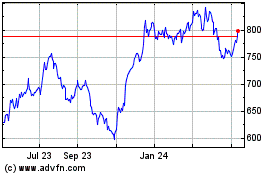BofA Finalizes CCB Stake Sale - Analyst Blog
August 30 2011 - 12:17PM
Zacks
On August 29, 2011, Bank of America Corp. (BAC)
announced that it has socked a deal with a group of investors to
sell about half of its stake in China Construction Bank (“CCB”) for
approximately $8.3 billion. This is part of BofA’s effort to
strengthen its capital position in order to reinstate dividend hike
and meet new international capital standards.
The CCB stake sale has long been anticipated by the market.
However, market turbulence in recent weeks made the deal
uncertain.
Bloomberg data showed that the company is the second largest
stake holder in CCB, the world’s second largest bank by value,
after the 59% right held by the Chinese government. Following the
divestiture of 13.1 billion of CCB common shares, BofA will still
continue as a strategic investor in CCB withabout 5% stake.
The proposed Basel III standards set a ceiling of less than 10%
stake in any financial institution. The reduction in the CCB stake
would help BofA to readily comply with the requirement.
The deal, which is expected to close in the third quarter of
2011, is expected to generate an after-tax gain of approximately
$3.3 billion during the quarter. The transaction is also likely to
help the company generate about $3.5 billion in additional Tier 1
common capital and reduce risk-weighted assets by $7.3 billion
under Basel I.
In 2005, BofA had paid $3 billion for a 9.9% stake in CCB,
before CCB’s IPO. The company further raised its stake by
exercising the option to purchase an additional 11% for $9.2
billion.
This is not the first time that BofA is selling its stake in
CCB. In January 2009, the company had sold 2.5% holdings in CCB,
reaping a profit of $1.1 billion. Further, in May 2009, the company
sold another 9.9% stake leading to a pre-tax profit of $7.3
billion. Also, in 2010, the company sold its right to buy another
1.79 billion shares in CCB to Temasek Holdings Pte, Singapore’s
state investment company.
Worries about BofA's ability to meet regulatory capital
requirement and maintain profitability have significantly eclipsed
the bank's stock price. However, the $5 billion investment made by
Warren Buffett's Berkshire Hathaway (BRK.B) in the
company on August 25, 2011, was real a confidence booster.
Also, the market expectation is that BofA requires about $50
billion additional capital in the coming years to meet global
capital standards. Amusingly, BofA has already generated about $30
billion from non-core asset shedding initiatives in the last six
quarters.
The company hopes to fulfill the regulatory capital requirement
through organic means, aided by the sustained paring of non-core
assets. However, we speculate that the company would need to issue
some shares to meet the capital requirement.
Besides fulfilling the capital requirements, BofA’s plan to sell
its stake in CCB is part of its long-term strategy to remove
non-core assets from its balance sheet as the company looks to
concentrate more on businesses that directly serve customers, as
well as fortify its balance sheet.
BofA has also broached talks with The Blackstone
Group (BX) to sell real estate assets held by its Merrill
Lynch unit for nearly $1 billion.
Moreover, early this month, the company agreed to sell its
Canadian credit-card unit to Toronto-Dominion Bank
(TD) for $7.6 billion.
BofA also shed a number of non-core assets earlier this year as
well as the last. Among others, BofA sold 43.6 million of its
BlackRock Inc. (BLK) shares for $163 each in
November 2010. Furthermore, the company sold an additional 2.5
million shares of BlackRock to Japan’s third-biggest bank Mizuho
Financial Group Inc. Also, in July 2010, BofA completed the sale of
First Republic Bank (FRC) for $1.86 billion to a
group of investors led by Colony Financial Inc.
(CLNY) and General Atlantic LCC.
Besides hiving off non-core assets, BofA is also planning to
retrench 3,500 workers this quarter as the company is fraught with
its $1 trillion problem-loan portfolio. Also, thousands of
additional layoffs could ensue in the upcoming quarters as the
company is working on a broader restructuring plan to recover its
financial position. Though BofA is still deliberating about the
extent of the job cut, the number might go beyond 10,000 as part of
a wider review.
We do not see an end to this non-core divestiture in the recent
future. With BofA’s plan to boost dividend in the second half of
2011 being turned down by the Federal Reserve in March, the company
sees this as an inevitable way to shore up capital strength and
fortify its balance sheet.
Currently, BofA retains a Zacks #4 Rank, which translates into a
short-term Sell rating. However, considering the fundamentals, we
maintain a long-term Neutral recommendation on the stock.
BANK OF AMER CP (BAC): Free Stock Analysis Report
BLACKROCK INC (BLK): Free Stock Analysis Report
BERKSHIRE HTH-B (BRK.B): Free Stock Analysis Report
BLACKSTONE GRP (BX): Free Stock Analysis Report
COLONY FINL INC (CLNY): Free Stock Analysis Report
FIRST REP BK SF (FRC): Free Stock Analysis Report
TORONTO DOM BNK (TD): Free Stock Analysis Report
Zacks Investment Research
BlackRock (NYSE:BLK)
Historical Stock Chart
From May 2024 to Jun 2024

BlackRock (NYSE:BLK)
Historical Stock Chart
From Jun 2023 to Jun 2024
